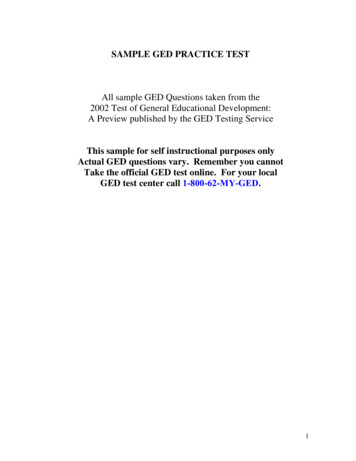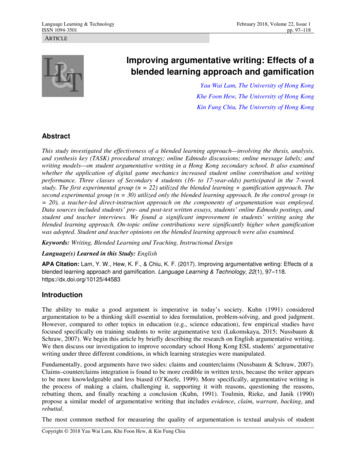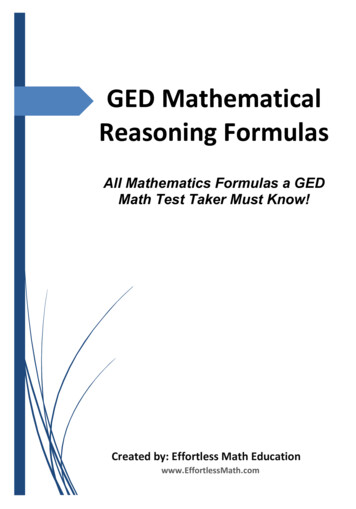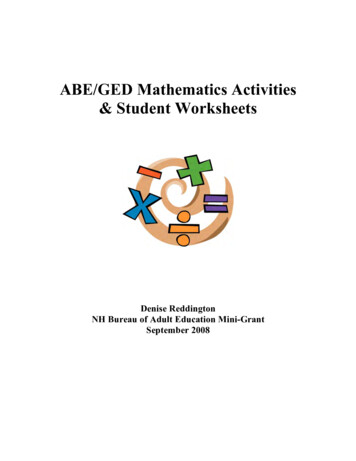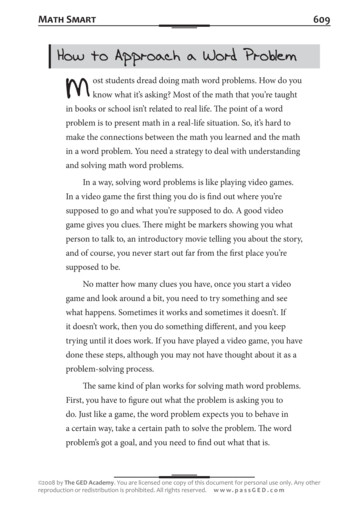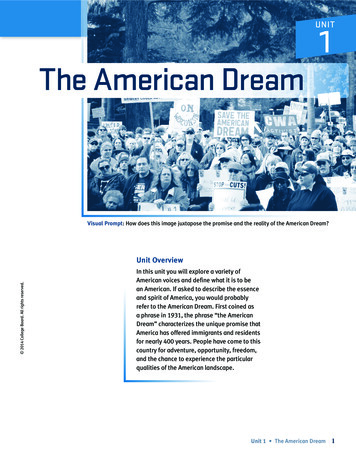
Transcription
Argumentative Writing: A Key toTeaching Constructed ResponseResources for the ClassroomBonnie Goonen and Susan PittmanJune 1-3, 2015 GED and GED Testing Service are registered trademarks of the American Council on Education. Used under license.Copyright 2015 GED Testing Service LLC. All rights reserved.
Table of ContentsResources for the Classroom . 1Extended Response Answer Guidelines – RLA Test . 32014 GED Program Free Practice Test RLA – Stimulus Material. 4RLA Writing Sample . 6Sample Annotated Paper . 7Sample Anchor Response for Science – Prompt 1 . 8Resources . 9Classic Model for an Argument . 10Graphic Organizers for Argumentative Writing . 12Unpacking Prompts . 12Close Reading Questions. 13Both Sides Now . 14Constructed Response Organizer . 16Sample Thesis/Claim Frames . 17Explain the Evidence . 19Assessing the Claim . 23Revising and Editing Checklist . 24Resources from the World Wide Web . 26 Copyright 2015 GED Testing Service LLC. All rights reserved. GED and GEDTesting Service are registered trademarks of the American Council on Education(ACE). They may not be used or reproduced without the express written permission ofACE or GED Testing Service. The GED and GED Testing Service brands areadministered by GED Testing Service LLC under license from the American Council onEducation. GED Testing Service www.GEDtestingservice.com Copyright 2015 GED Testing Service LLC. All rights reserved.2
Extended Response Answer Guidelines – RLA TestPlease use the guidelines below as you answer the Extended Response question onthe Reasoning Through Language Arts test. Following these guidelines as closely aspossible will ensure that you provide the best response.1. Please note that this task must be completed in no more than 45 minutes.However, don’t rush through your response. Be sure to read through the passage(s)and the prompt. Then think about the message you want to convey in yourresponse. Be sure to plan your response before you begin writing. Draft yourresponse and revise it as needed.2. As you read, think carefully about the argumentation presented in the passage(s).“Argumentation” refers to the assumptions, claims, support, reasoning, andcredibility on which a position is based. Pay close attention to how the author(s)use these strategies to convey his or her positions.3. When you write your essay, be sure to: determine which position presented in the passage(s) is better supported byevidence from the passage(s) explain why the position you chose is the better-supported one remember, the better-supported position is not necessarily the positionyou agree with defend your assertions with multiple pieces of evidence from the passage(s) build your main points thoroughly put your main points in logical order and tie your details to your main points organize your response carefully and consider your audience, message, andpurpose use transitional words and phrases to connect sentences, paragraphs, andideas choose words carefully to express your ideas clearly vary your sentence structure to enhance the flow and clarity of your response reread and revise your response to correct any errors in grammar, usage, orpunctuationRetrieved from the World Wide Web 74e3cf83a8cae5b05e5627fd2754e87f.pdf GED Testing Service www.GEDtestingservice.com Copyright 2015 GED Testing Service LLC. All rights reserved.3
2014 GED Program Free Practice Test RLA – Stimulus MaterialAn Analysis of Daylight Saving Time1Twice a year, most Americans adjust their clocks before bedtime to prepare forDaylight Saving Time (DST). Every spring, clocks are moved ahead one hour. Inthe fall, they are moved back one hour, and all to maximize the benefits of the sun.DST was first implemented in the United States in 1918 to conserve resources forthe war effort, though proponents encouraged its adoption long before then.Benjamin Franklin, for example, touted the idea of DST to citizens of France wayback in 1784!DST in America2For years following DST's U.S. debut, cities could choose if and when they wantedto participate. However, by the 1960s, the open choice resulted in various citiesthroughout the United States using different times. These varying times createdconfusion, particularly for entertainment and transportation schedules. Imaginetraveling across several states, each adhering to its own little time zone!3In order to remedy the confusing situation, Congress established a start and stopdate for DST when it passed the Uniform Time Act of 1966. Although this acthelped clarify when DST went into effect around the country, cities were notrequired to use DST. To this day, parts of Arizona and all of Hawaii, for example,do not use DST.Benefits of DST4Many studies have investigated the benefits and costs of DST. Research in the1970s found that DST saved about 1% per day in energy costs. On average, mostelectricity used is for lighting and appliances. It makes sense that more sun at theend of the day meant less need for electricity. This follows right along with BenFranklin's argument over 200 years ago.5Supporters of DST also claim that more sunlight saves lives. Studies haveindicated that traveling home from work or school in daylight is safer. Nearly threedecades of research shows an 8-11% reduction in crashes involving pedestriansand a 6-10% decrease in crashes for vehicle occupants after the spring shift toDST.6Other studies reveal that, following a similar logic, DST reduces crime becausepeople are out completing chores after their business or school day in sunlight,lessening their exposure to crimes that are more common after dark. GED Testing Service www.GEDtestingservice.com Copyright 2015 GED Testing Service LLC. All rights reserved.4
Arguments against DST7Opponents of DST cite other studies that disagree with these outcomes. A 2007study in California indicated that DST had little or no effect on energy consumptionthat year. A three-year study of counties in Indiana showed that residents of thatstate spent 8.6 million more each year for energy, and air pollution increased afterthe state switched to DST. The researchers theorized that the energy jump wascaused in part by increased use of air conditioning as a result of maximizingdaylight hours.8Recent research has also brought into question the safety aspect of the yearlyswitch to and from DST. In one study, pedestrian fatalities from cars increasedimmediately after clocks were set back in the fall. Another study showed 227pedestrians were killed in the week following the end of DST, compared with 65pedestrians killed the week before DST ended.9The adjustment period drivers endure each year is a dangerous time forpedestrians, and Daylight Saving Time may be the reason. Instead of a gradualtransition in the morning or afternoon by just minutes of sunlight each day, theimmediate shift of one hour forward or backward fails to provide drivers andpedestrians time to adjust.10 When you also consider the cost of the abrupt transition in terms of confusioncaused by people who forget to adjust their clocks, opponents say, any benefitsgained by DST are simply not worth the trouble.PromptThe article presents arguments from both supporters and critics of Daylight Saving Timewho disagree about the practice's impact on energy consumption and safety.In your response, analyze both posit ions presented in the article to determine whichone is best supported. Use relevant and specific evidence from the article to supportyour response.Type your response in the box below. You should expect to spend up to 45 minutes inplanning, drafting, and editing your response. GED Testing Service www.GEDtestingservice.com Copyright 2015 GED Testing Service LLC. All rights reserved.5
RLA Writing SampleBetween the two positions in this article, the one against Daylight Saving Time is bettersupported. Although both positions are well organized and supported with severalexamples, the evidence supporting the view against DST is more specific and thorough.The first position makes some valid points, ones that are sure to catch any reader'sattention. The writer brings up expenses, safety, and crime rates, all of which aresupposedly improved through the use of DST. However, the evidence he uses tosupport this claim seems general and outdated. In paragraph four, he mentions that onestudy took place in the 1970s. He also uses phrases such as "many studies" and "otherstudies." While the points he makes are interesting, there are no specifics. One is leftwondering just how outdated or reliable these studies are, and if they even apply to theaverage American. Had he used less generalized phrases, he may have sounded moreconvincing.The second position is much better supported, especially compared to the somewhatlacking arguments of the previous position. The writer's information is precise, and heseems to use more studies than the first author. While the first author used studies fromthe 1970s, this one mentions a study done in 2007. The specifics of each study alsoimprove the quality and seeming validity of the arguments made. The writer gives thestates in which the studies were conducted and the reasons why the researchersbelieved they got those results. Also, like the first author, the issues of which he writesare ones that will catch the reader's attention: energy consumption, safety, andconfusion. While they are similar to those points brought up by the first writer, thissecond position is far better supported through its organization and attention to detail.From the “The 2014 GED Test – Reasoning Through Language Arts (RLA) ExtendedResponse Resource Guide for Adult Educators” p. 18 GED Testing Service www.GEDtestingservice.com Copyright 2015 GED Testing Service LLC. All rights reserved.6
Sample Annotated PaperTest-Taker Anchor Response 7 –Score: 2 [Trait 1]Thomas Jefferson states very clearly, andwithout faltering, that while the country will berepresented by the desires of the majority, thatthe rights of the minority will not be infringedupon in the process. The letter submitted by Ms.Parsons demonstrates that the country continuesto uphold this principle almost 150 years afterThomas Jefferson made that statement.In the issue at hand the United States SupremeCourt struck down a mandate that all studentsrecite the Pledge of Allegiance and salute theflag each morning. In some situations, such as inthe case of the Jehovah's Witnesses, saying thePledge while saluting the flag violates theirreligious beliefs, and so therefore their freedomof religion. However, it was not ruled to be aviolation of their freedom of religion, but rather oftheir freedom of speech, to say or not say whatthey desired.There is nothing wrong with asking children tosay the Pledge of Allegiance, as pointed out bythe author. It is wrong, nevertheless, to requirethat this be done under penalty of punishment. Itresonates with Nazi idealisms of the time, thatyou would salute Hitler and obey the Nazi regimeor face death or internment. We as a peoplewere appalled by these revelations, but WestVirginia, in their desire to prove the patriotism oftheir students, attempted to take the UnitedStates one step closer to this fanatasism.Despite that, the Supreme Court struck down thelaw and prevented one of the most basicfreedoms we as Americans hold dear from beingtrampled upon by a majority opinion.AnnotationThe writer of this response generates anargument that demonstrates a clearunderstanding of how the enduring issue ofminority rights expressed in the excerpt fromThomas Jefferson is reflected in the Parsonsletter ("Thomas Jefferson states very clearly . . .that while the country will be represented by thedesires of the majority, that the rights of theminority will not be infringed upon in the process.The letter submitted by Ms. Parsonsdemonstrates that the country continues touphold this principle almost 150 years afterThomas Jefferson made that statement.").The writer cites evidence from the letter tosupport the analysis in the second and thirdparagraphs of the response (example: " . . . theUnited States Supreme Court struck down amandate that all students recite the Pledge ofAllegiance and salute the flag each morning. Insome situations, such as in the case of theJehovah's Witnesses, saying the Pledge whilesaluting the flag violates their religious beliefs,and so therefore their freedom of religion.However, it was not ruled to be a violation oftheir freedom of religion, but rather of theirfreedom of speech, to say or not say what theydesired.").Additionally, the response includes informationfrom the writer's own knowledge of the broaderhistorical context to support the argument ("Itresonates with Nazi idealisms of the time, thatyou would salute Hitler and obey the Nazi regimeor face death or internment."). As a whole, thisresponse is well-connected to both the promptand the source texts.Therefore, Response 7 earns a score of 2 forTrait 1.Trait Score 2 – 1Trait Score 3 - 1 GED Testing Service www.GEDtestingservice.com Copyright 2015 GED Testing Service LLC. All rights reserved.7
Sample Anchor Response for Science – Prompt 1Wind energy is far more resourceful compared to coal. Coal has ongoing fuel costs, andhas many more impacts to the environment as wind energy does not. Wind does notproduce any Co2 emissions, as where coal produces 200 pounds of CO2 emissions perkWh. Coal has many impacts that will affect the environment in the long run, as to windenergy. Simple inconveniences are the main issue. The effects of wind energy wouldhelp with the coal consumption. Projections show that coal resources will only last 100years if we don’t find alternate energy sources.AnnotationScore Explanation: This test-takers response includes complete support from the table.(Coal has ongoing fuel costs, and has many more impacts to the environment as windenergy does not) and (Wind does not produce any Co2 emissions, as where coalproduces 200 pounds ). Additionally, the test-taker provides a holistically completeexplanation for how the energy supply of coal will be affected, (wind energy would helpcoal consumption. Projections show that coal resources will only last 100 years if wedon’t find alternate energy sources.). Although the explanation lacks some of thedevelopment that is typical for responses that receive scores of 3, this particularresponse uses high quality support from the data table, which helps compensate for thelack of detail in the explanation. GED Testing Service www.GEDtestingservice.com Copyright 2015 GED Testing Service LLC. All rights reserved.8
Resources GED Testing Service www.GEDtestingservice.com Copyright 2015 GED Testing Service LLC. All rights reserved.9
Classic Model for an ArgumentNo one structure fits all written arguments. However, argumentative writing consists of thefollowing elements. Below is a basic outline for an argumentative or persuasive essay.I.Introductory Paragraph – Set up Your ClaimYour introductory paragraph sets the stage or the context for the position for whichyou are arguing. The introduction should include a thesis statement that providesyour claim (what you are arguing for) and the reasons for your position on an issue.Your thesis or claim: states what your position on an issue is usually appears at the beginning or ending of the introduction in a short essay should be clearly stated and should contain emphatic language (should,ought, must)II.Body of your Argument – Support Your ClaimA. Background Information – Lays the foundation for proving your argumentThis section of your paper gives the reader the basic information he or she needsto understand your position.This section will often include: A summary of works being discussed A definition of key terms An explanation of key theoriesB. Reasons or Evidence to Support your ClaimAll evidence you present in this section should support your position. This is thefocus of your essay. Generally, you begin with a statement that you back up withspecific details or examples. Make sure to connect the evidence to the claim. Thereader should be able to see that there is a logical, persuasive connectionbetween the claim, reasons, and data (evidence). Depending on how long yourargument is, you will need to devote one to two well-developed paragraphs toeach reason/claim or type of evidence.Sample Format for Supporting Evidence Paragraph Topic Sentence: What is one item, fact, detail, or example you can tell yourreaders that will help them better understand your claim/paper topic? Youranswer should be the topic sentence for this paragraph. Introduce Evidence: Introduce your evidence either in a few words (As Dr.Brown states . . .) or in a full sentence (To understand this issue. we firstneed to look at statistics). State Evidence: What supporting evidence (reasons, examples, facts,statistics, and/or quotations) can you include to prove/support/explain yourtopic sentence? GED Testing Service www.GEDtestingservice.com Copyright 2015 GED Testing Service LLC. All rights reserved.10
Explain Evidence: How should we read or interpret the evidence you areproviding us? How does this evidence prove the point you are trying tomake in this paragraph? Can be opinion based and is often at least 1-3sentences.Concluding/Transitional Sentence(s): End your paragraph with aconcluding sentence that reasserts how the topic sentence of thisparagraph helps up better understand and/or prove your paper’s overallclaim and how it transitions to the next idea. III.Addressing the Opposite Side – Refute the ObjectionsAny well-written argument must anticipate and address positions in opposition to theone being argued. Pointing out what your opposition is likely to say in response toyour argument establishes that you have thought critically about your topic.Addressing the opposite side actually makes your argument stronger! Generally, thistakes the form of a paragraph that can be placed either after the introduction orbefore the conclusion. Often this is phrased as an opposing view and the refutation tothe view.Sample Format for Supporting Evidence Paragraph Introduce the Counterargument – this could be one or more argumentsagainst your thesis State the Evidence – what evidence is provided in the text(s) Refute the Evidence – argue against the evidence and why the stance thatyou have selected is the better supported Concluding/Transitional Sentence(s) – end the paragraph with informationthat reasserts your position as a whole.IV.ConclusionThe conclusion should bring the essay to a logical end. However, your conclusionshould not simply restate your introductory paragraph. Your conclusion shouldexplain what the importance of your issue is in a larger context. Your conclusionshould also reiterate why your topic is worth caring about. Some arguments proposesolutions or make prediction on the future of the topic.Adapted from:Odegaard Writing and Research Center. http://www.depts.washington.edu/owrcPurdue OWL Writing Lab. https://owl.english.purdue.edu/owl/The Writing Center at UNC Chapel Hill. http://writingcenter.unc.edu/handouts/The Writer’s Workplace. Ed. Sandra Scarry and John Scarry. 6th ed. Boston: ThomsonWadsworth, 2008. GED Testing Service www.GEDtestingservice.com Copyright 2015 GED Testing Service LLC. All rights reserved.11
Graphic Organizers for Argumentative WritingUnpacking PromptsDo GED Testing Service www.GEDtestingservice.com Copyright 2015 GED Testing Service LLC. All rights reserved.What12
Close Reading QuestionsAfter they have read the excerpt(s), can your students answer thesequestions? What is the author’s argument? What position does the author take (for or against)? What is one point that supports the author’s argument? What evidence does the author give to support this point? What is the point of view of the author? What is one point that refutes the author’s point of view? GED Testing Service www.GEDtestingservice.com Copyright 2015 GED Testing Service LLC. All rights reserved.13
Both Sides NowWhen reading argumentative non-fiction text, materials often present one side or viewpoint on aparticular issue. Sometimes, the text may provide evidence to support both sides. Then, it is up tothe reader determine which is best supported. Analyzing and evaluating the evidence for both sidesis one way to identify a claim and the reasons for making a specific decision/claim.Both Sides NowEvidence thatEvidence that OpposesSupportsQuestion or statementWhich position is bestsupported?Decision (Claim)Reasons (Analysis/Evaluation) GED Testing Service www.GEDtestingservice.com Copyright 2015 GED Testing Service LLC. All rights reserved.14
Prewriting Organizer: Toulmin Model for ArgumentationA Claim:Is your pointIs debatableIs demonstrated by reason and logicThesis/Claim Statement:ReasonWarrants: Just like asearch warrant from the police,the argument warrant gives thewriter authority to proceed withhis/her argument. is the assumption thatmakes your claimplausible questions the evidence shows a logical,persuasive connectionbetween claim, reasons,data (evidence) gives authority toproceed with yourargument can be stated, butusually is assumedREFUTEReasonReasonReasonConclusion GED Testing Service www.GEDtestingservice.com Copyright 2015 GED Testing Service LLC. All rights reserved.15
Constructed Response OrganizerPrompt/Question:Restatement ofquestion in ownwords (unpack it)ClaimText 1Text 2ClaimRebuttalEvidenceDetailed body ofevidence orreasons thatsupport answer –include enoughdetails to answerthe question. Makesure all detailssupport the claimand are not offtopic.Counterargument(s)Restated questionConcludingthoughts GED Testing Service www.GEDtestingservice.com Copyright 2015 GED Testing Service LLC. All rights reserved.16
Sample Thesis/Claim FramesA thesis is an answer to a specific question. A thesis statement makes a claim orproposition that reflects a specific point of view. The thesis statement should recognizeboth sides of a question, yet focus on two to three specific points (discussion points)sometimes called points of analyses. A thesis statement is the roadmap for the writtenresponse. The placement of the thesis statement is generally located in the introductionand summarized in the conclusion of a writing sample.The general argument made by in his/her work is thatbecause .Although (believes, demonstrates, argues) that, supports/providesthe clearest evidence .A key factor in both can be attributed to.When comparing the two positions in this article, provides theclearest evidence that .Looking at the arguments regarding , it is clear that .In discussion of , one controversial issue has been. believes that. On the other hand,asserts that .is clearly the best supported argument on the issue of. GED Testing Service www.GEDtestingservice.com Copyright 2015 GED Testing Service LLC. All rights reserved.17
How Do You Know? – Frames for Incorporating EvidenceIn the article, “ ,” maintains that.’s point is that’s claim rests upon the questionable assumption thatOne reason that maintains the position ofis thatAccording to the text/article/passage/report,An example of , is. This proves/supports thatThe author states thatIn addition, the author/article/research supports that. This proves that .Examples/data supporting , include GED Testing Service www.GEDtestingservice.com Copyright 2015 GED Testing Service LLC. All rights reserved.18
Explain the EvidenceTeach students how to identify evidence through direct quotes, paraphrasethe information, and explain how the evidence supports the claim/thesis.ClaimUsing a DirectQuote(What directquote supportsthe claim?)Paraphrasing(How can yourewrite the directquote in yourown words?) GED Testing Service www.GEDtestingservice.com Copyright 2015 GED Testing Service LLC. All rights reserved.Explanation(How does theevidence supportthe claim?)19
Sentence Structures: Helping Students Discuss, Read, and WriteAbout TextsStudents at all levels struggle to find language that expresses their ideas and helpsthem achieve their rhetorical purpose. Sentence structures offer a useful means ofgetting students up and running with academic language through either sentencestarters or sentence frames. Both approaches are useful for writing about anddiscussing different types of texts.Sentence StartersMaking Predictions I predict that If x happens, then Because x did y, I expect z.Making Connections X reminds me of X is similar to y because X is important to y because Making Inferences X means . . . since x is Early on the author says whichsuggests X is X causes y as a result of whichshows Summarizing The main (central) idea is The author argues that In , (author’s name) implies Evaluating The author’s point is/is not validbecause The author does/does not do a goodjob of The most important aspect/event/ideais Analyzing the Text The author uses toshow/achieve Sentence FramesSummarizing Readers often assume that . While many suggest x, others say y . (Author’s name) agrees/disagrees withx, pointing out Responding X claims which I agree/disagree withbecause . X’s point assumes x, which I wouldargue means While I agree that , you couldalso say Agreeing Most will agree that I agree with those who suggest that X offers an effective explanation of whyy happens, which is especially usefulbecause most think that .Disagreeing I would challenge x’s point about y,arguing instead. X claims y, but recent discoveries showthis is While X suggests y, this cannot be truesince Taking the Third Path: Agreeing andDisagreeing While I agree that , I reject the largerargument that since we now know I share X’s belief that , butquestion due to GED Testing Service www.GEDtestingservice.com Copyright 2015 GED Testing Service LLC. All rights reserved.20
The author assumes whichis/is not true The use ofstrengthens/weakens the author’sargument by Clarifying What the author is saying is Given that x happened, the author istrying to show X is not but is, instead,since . Most concede x though few wouldagree that y is true Arguing Although x is increasing/decreasing, itis not y but z that is the cause While x is true, I would argue ybecause of z. X was, in the past, the most importantfactor but y has changed, making it thereal cause.Explaining Importance Based on x, people assumed y, whichSynthesizingmade sense at the time, but now we These elements/details, whenrealize z, which means .considered together, suggest This change questions our previous Initial impressions suggested x, butunderstanding of x, which means thatafter learning it is now clearnow we must assume that It is not a question of x but ratherof y because . While this conclusion appearsinsignificant, it challenges our current understandingof x, which means that Sentence starters and frames from: “A Cognitive Strategies Approach to Reading andWriting Instruction for English Learners in Secondary School,” by Olson and Land inResearch in the Teaching of English (Feb 2007) and They Say/I Say: The Moves thatMatter in Academic Writing, by Graff and Birkenstein (Norton 2006/2010). GED Testing Service www.GEDtestingservice.com Copyright 2015 GED Testing Service LLC. All rights reserved.21
Connecting Ideas – Using Transitional Words and Phrases (Odell Education)Transitional words and phrases create link between your ideas when you are speaking and writing. They help youraudience understand the logic of your thoughts. When using transitional words, make sure that it is the right match forwhat you want to express. Remember, transition words work best when they are connecting two or more strong ideas thatare clearly stated. The following is a list of transitional words and phrases that you can use for different purposes.Add RelatedInformationGive an Example orIllustra
Be sure to plan your response before you begin writing. Draft your response and revise it as needed. 2. As you read, think carefully about the argumentation presented in the passage(s). “Argumentation” refers to the assumptions, claims, support, reasoning, and credibility on which a po
